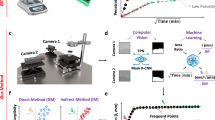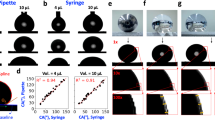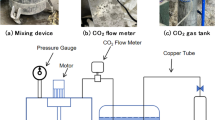Abstract
WHEN a freshly prepared cement paste is left at rest, the cement particles tend to settle downwards. Water displaced in the motion permeates up through the paste and accumulates as a layer on the top. This process is described as segregation or “bleeding” when it occurs in concrete. A study of the bleeding of Portland cement paste, mortar and concrete, treated as a special case of sedimentation, has been carried out by Powers1 and Steinour2,3. In their experiments they measured the settlement of the upper surfaces of paste samples in cylindrical containers. At the concentrations normally used in practice, with water–cement ratios of 0.30–0.65 by weight, a linear rate of settlement was observed for the first 30 min or so of a test, and the rate then decreased until settlement stopped1. Similar tests made on the same kind of paste, but on samples of different heights, showed that the initial rate of bleeding remained the same regardless of height. Powers inferred that these results “illustrated the whole process of bleeding, showing not only the movement visible at the top surface but also simultaneous changes that go on below the surface”1. He deduced that during the settling period there are four zones within the paste. At the top is a layer of clear water, followed by a zone of constant water content (initial water–cement ratio) and constant rate of settling. Below this is a transition zone of decreasing water content and decreasing rate of settlement, which extends to the bottom zone of maximum compaction and zero rate of settlement.
This is a preview of subscription content, access via your institution
Access options
Subscribe to this journal
Receive 51 print issues and online access
$199.00 per year
only $3.90 per issue
Buy this article
- Purchase on SpringerLink
- Instant access to full article PDF
Prices may be subject to local taxes which are calculated during checkout
Similar content being viewed by others
References
Powers, T. C., Portland Cement Assoc. Bull., 2 (1939).
Steinour, H. H., Portland Cement Assoc. Bull., 3 (1944).
Steinour, H. H., Portland Cement Assoc. Bull., 4 (1945).
Powers, T. C., Portland Cement Assoc. Bull., 53 (1955).
Preiss, K., Mat. Res. Stand., 5, 285 (1965).
Author information
Authors and Affiliations
Rights and permissions
About this article
Cite this article
WHEELER, J. Mechanism of Settling in Cement Paste. Nature 212, 1035–1036 (1966). https://doi.org/10.1038/2121035a0
Issue date:
DOI: https://doi.org/10.1038/2121035a0
This article is cited by
-
Essais de traction directe sur des pâtes pures de ciment durcies
Matériaux et Constructions (1977)
-
Étude des propriétés mécaniques des pâtes pures de ciment durcies
Matériaux et Constructions (1974)



